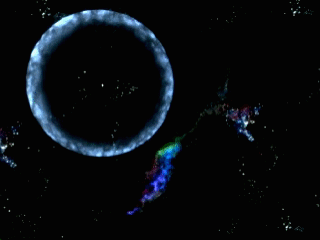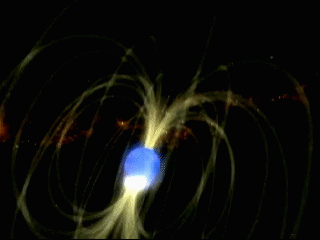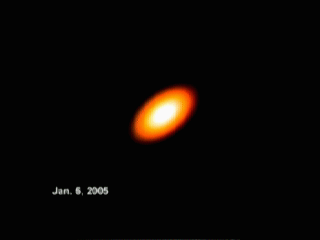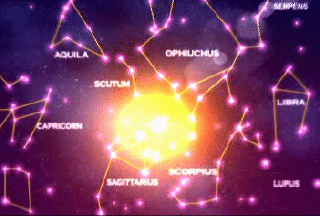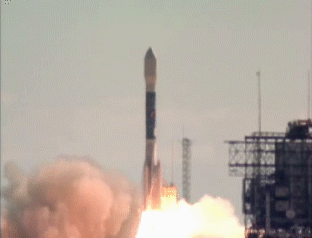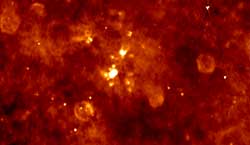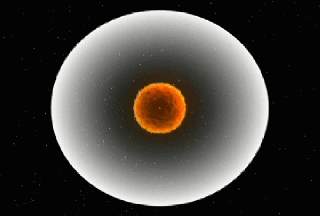|
March 25, 2005 from ExopoliticsBlogs Website
VANCOUVER, B.C.
This article summarizes the evidence upon which to hypothesize that the Asian Tsunami of December 26, 2004 (Boxing Day) may have been caused by gravity waves from the Galactic Center of the Milky Way Galaxy, which accompanied a gamma ray burst caused by the explosion of a Neutron Star in the Constellation Saggitarius, some 45,000 light years from Earth.
The article also summarizes
analysis of whether the December 27, 2004 event may be an indicator
that a cyclical Galactic Superwave event, recurrent every 13,000 and
26,000 years, may have begun. The
Mayan Calendar's current TUN, or
organic unit of Galactic time, ends on December 21, 2012.
Others analyze the 13,000 and 26,000 year cycles of the Galactic Superwaves in the context of spiritual and prophetic texts.
Under the Mayan Calendar, this TUN, or organic unit of Galactic time
is scheduled to end and a new TUN is scheduled to begin on December
21, 2012. According to the "Prophetic" frame of perception, the
December 26-27, 2005 Gravity Wave/Tsunami was a Warning that
humanity should move out of a permanent warfare economy into a
peaceful, sustainable, cooperative, Universe-oriented Space Age
society, seeking to integrate with Universe society.
In this light, the development of Exopolitics at this juncture in human history seems fortuitous, "just in time." The Exopolitics model postulates the Earth resides is a populated, organized Universe, operating under Universal law, with forms of Universal governance, and mediated by the processes of Universe politics amongst its constituent civilizations.
Exopolitics provides an institutional and educational bridge for integrating Earth into Universe society. Is one central reason for the outreach of the UFO phenomenon since 1947 to prepare human society for this integration, knowing that the stress of a cyclical Galactic Superwave event would occur by 2012, hypothetically?
If there is any truth to this
hypothesis, then Exopolitics is the discipline that human society
requires to implement that integration - politically, socially,
legally, constitutionally, ethically, and Spiritually.
Two specific programs proposed by Exopolitics are:
It has not been determined to a certainty that
Galactic Gravity
Waves caused the December 26, 2004 Tsunami and the many Earth
Changes we are witnessing at this time, and which are documented in
this article. Nor do we know for a certainty when any Galactic Superwave will strike with the next 10 years, be that on March 6,
2005, as one observer hypothesizes, or before
December 21, 2012, or
even in this Century.
Is the Galactic Superwave a form of the War Against the Asteroids, another strategic deception operation to derail humanity away from transforming the permanent warfare state? That is doubtful...
The
papers below are based on science, and an Exopolitical strategy of
reaching out to Universe society seems healthy, sane, ethical and
Agape-based, not a strategy based on deception.
from NASA Website
Scientists have detected a flash of light from across the Galaxy so powerful that it bounced off the Moon and lit up the Earth's upper atmosphere.
The flash was brighter than anything ever detected from beyond our Solar System and lasted over a tenth of a second. NASA and European satellites and many radio telescopes detected the flash and its aftermath on December 27, 2004. Two science teams report about this event at a special press event today at NASA headquarters.
A multitude of papers are planned for publication. Artist conception of the December 27, 2004 gamma ray flare expanding from SGR 1806-20 and impacting Earth’s atmosphere. Click on image to view animation - Wait up to 60 seconds for file to load (no audio)
Credit: NASA
The scientists said the light came from
a "giant flare" on the surface of an exotic neutron star, called a
magnetar. The apparent magnitude was brighter than a full moon and
all historical star explosions. The light was brightest in the
gamma-ray energy range, far more energetic than visible light or
X-rays and invisible to our eyes. Image/animation above: Image 2: An artist conception of the SGR 1806-20 magnetar including magnetic field lines. After the initial flash, smaller pulsations in the data suggest hot spots on the rotating magnetar’s surface. The data also shows no change in the magentar’s rotation after the initial flash. Click on image to view animation - Wait up to 60 seconds for file to load (no audio)
Credit: NASA NASA's newly launched Swift satellite and the NSF-funded Very Large Array (VLA) were two of many observatories that observed the event, arising from neutron star SGR 1806-20, about 50,000 light years from Earth in the constellation Sagittarius.
Image/animation above: Image 3: Radio data shows a very active area around SGR1806-20. The Very Large Array radio telescope observed ejected material from this Magnetar as it flew out into interstellar space. These observations in the radio wavelength start about 7 days after the flare and continue for 20 days. They show SGR1806-20 dimming in the radio spectrum. Click on image to view animation - Wait up to 60 seconds for file to load (no audio)
Credit: NRAO/CfA/Gaensler & Univ. of
Hawaii.
Dr. Bryan Gaensler of the
Harvard-Smithsonian Center for Astrophysics in Cambridge, Mass., is
lead author on a report describing the VLA observation, which
tracked the ejected material as it flew out into interstellar space.
Other key scientific teams are associated with radio telescopes in
Australia, The Netherlands, United Kingdom, India and the United
States, as well as with NASA's High Energy Solar Spectroscopic
Imager (RHESSI).
Millions of neutron stars fill our Milky Way galaxy. Image/animation above: Image 4: SGR-1806 is an ultra-magnetic neutron star, called a magnetar, located about 50,000 light years away from Earth in the constellation Sagittarius. Click on image to view animation - Wait up to 60 seconds for file to load (no audio)
Credit: NASA
Scientists have discovered about a dozen
ultrahigh-magnetic neutron stars, called
magnetars. The magnetic
field around a magnetar is about 1,000 trillion gauss, strong enough
to strip information from a credit card at a distance halfway to the
moon. (Ordinary neutron stars measure a mere trillion gauss; the
Earth's magnetic field is about 0.5 gauss.)
The total energy produced was more than the Sun emits in 150,000 years. Image/animation above: Image 5: Swift is a first-of-its-kind multi-wavelength observatory dedicated to the study of gamma ray burst (GRB) science. Its three instruments will work together to observe GRBs and afterglows in the gamma ray, X-ray, ultraviolet, and optical wavebands. Swift is designed to solve the 35-year-old mystery of the origin of gamma-ray bursts. Scientists believe GRB are the birth cries of black holes. Click on image to view animation - Wait up to 60 seconds for file to load (no audio) Credit: NASA
A scientific debate raged in the 1980s over whether gamma-ray bursts were star explosions from beyond our Galaxy or eruptions on nearby neutron stars. By the late 1990s it became clear that gamma-ray bursts did indeed originate very far away and that SGRs were a different phenomenon.
But the extraordinary giant flare on SGR 1806-20 reopens the debate, according to Dr. Chryssa Kouveliotou of NASA Marshall Space Flight Center, who coordinated the multiwavelength observations. Image/animation above: Image 6: NASA's Swift satellite was successfully launched Saturday, November 20, 2004 from the Cape Canaveral Air Force Station, Fla. Click on image to view animation - Wait up to 60 seconds for file to load
Credit: NASA A sizeable percentage of "short" gamma-ray bursts, less than two seconds, could be SGR flares, she said. These would come from galaxies within about a 100 million light years from Earth. (Long gamma-ray bursts appear to be black-hole-forming star explosions billions of light years away.)
Scientists around the world have been following the December 27 event.
RHESSI detected gamma rays and X-rays from the flare. Drs. Kevin Hurley and Steven Boggs of the University of California, Berkeley, are leading the effort to analyze these data.
Dr. Robert Duncan of the University of Texas at
Austin and Dr. Christopher Thompson at the Canadian Institute for
Theoretical Astrophysics (University of Toronto) are the leading
experts on magnetars, and they are investigating the "short
duration" gamma-ray burst relationship.
Amateur astronomers detected the disturbance in the Earth's ionosphere and relayed this information through the American Association of Variable Star Observers.
Image above: SGR 1806-20 is a "magnetar": a rapidly spinning neutron star that not only has an incredible density, trillions of times greater than than ordinary matter, but an incredibly strong magnetic field. Tens of thousands of years ago, a "starquake" fractured the magnetar's surface. The result was an explosive release of energy, which sent a pulse of gamma rays racing across the cosmos at the speed of light. Behind them came the explosion's fireball, expanding in a lopsided fashion at roughly one-third the speed of light. The gamma rays swept past the Earth on December 27, 2004, when they were detected by NASA's Swift satellite. That initial signal faded away within minutes. But then came a steady stream of radio waves from the fireball. Astronomers rushed to ground-based radio telescopes such as NSF's Very Large Array outside Socorro, New Mexico, where they have been studying the information-rich signal ever since.
|

